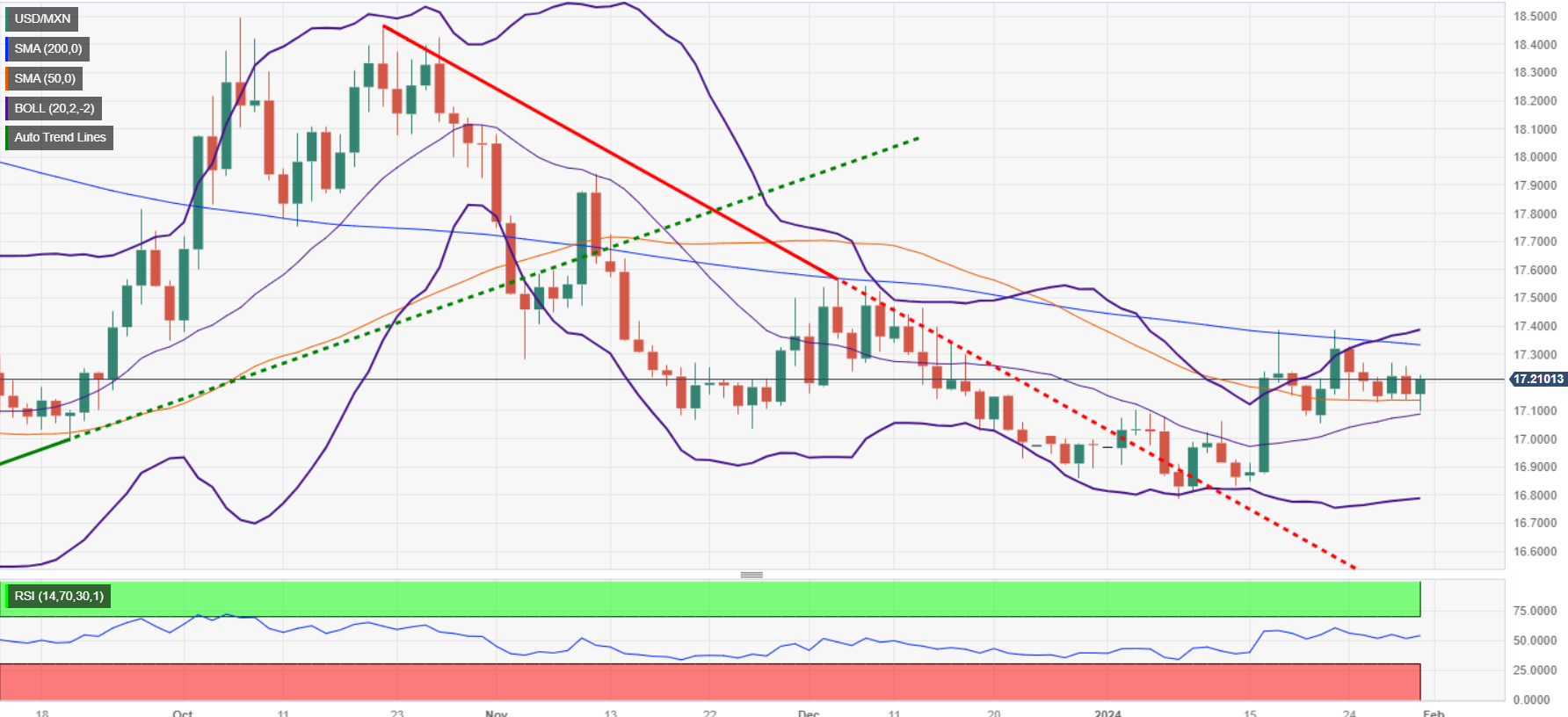Most recent article: Mexican Peso rises after mixed US data, Fed’s decision
- Mexican Peso falls over 0.20% against the US Dollar, in response to the Fed's decision to hold rates and a cautious tone from Chair Powell.
- Powell's balanced approach and dismissal of a March rate cut weakens the Peso against the USD.
- The Fed's commitment to reducing its balance sheet as planned and a meeting-by-meeting approach to rate decisions
- Fed's unanimous decision to maintain interest rates and cautious approach to future rate cuts heightens market risk aversion.
- US employment data and a low Employment Cost Index shows the labor market is cooling.
The Mexican Peso (MXN) edges lower against the US Dollar (USD) on Wednesday and posted losses of more than 0.20% as risk aversion drove the financial markets after the US Federal Reserve (Fed) decided to hold rates, but stroke a hawkish stance. In addition, Fed Chair Jerome Powell was balanced and poured cold water on market participants expecting a March rate cut. Therefore, the USD/MXN trades at 17.20 after hitting a daily low of 17.09.
The Fed Chair Jerome Powell remarked that policy may have peaked while stating that policy could be eased this year. He added the Fed would take a meeting-by-meeting approach and would depend on how the economy evolves. Powell noted the current uncertainty surrounding the economic outlook and emphasized that decisions regarding monetary policy would be made on a case-by-case basis in each meeting.
He also pointed out that rate cuts were not a topic of discussion in their recent meeting, signaling that the Federal Reserve is not yet ready to consider itself victorious in its efforts against inflation. Furthermore, Powell recently conveyed his belief that a rate cut in March is not likely to be on the agenda.
Daily digest market movers: Mexican Peso slides after Fed’s meeting
- On Wednesday, the Federal Reserve decided to keep rates unchanged as widely expected and adopted a neutral stance. Officials had opened the door to cut interest rates, though they need some reassurance that inflation is “sustainably” getting towards its 2% goal. In regards to the balance sheet, its reduction would continue as outlined on May of 2023.
- The Employment Cost Index (ECI), a key indicator of wage inflation monitored by Federal Reserve officials, fell from 1.1%QoQ to 0.9% in the fourth quarter, indicating a cooling in the labor market.
- The ADP Employment Change report for the United States showed weaker performance in January, with private hiring rising only 107K jobs, falling short of December’s 158K and the predicted 145K. The report mentioned, “Progress on inflation has brightened the economic picture despite a slowdown in hiring and pay.” As wages had improved in the last semester, “the economy looks like it’s headed toward a soft landing.”
- Mexico’s economy grew below forecasts in the last quarter of 2023. GDP expanded 0.1% QoQ, trailing Q3 1.1% growth and forecasts of 0.4%.
- Given that the Mexican economy remains solid, according to the data revealed in January, the Bank of Mexico (Banxico) could delay easing monetary policy as conditions remain hotter than expected.
- However, if Banxico’s officials remain determined to begin its easing cycle in Q1 of 2024, that could depreciate the emerging market currency due to the reduction of interest rate differentials. That could also underpin the USD/MXN pair toward the psychological 18.00 figure.
- The US labor market remains solid as the latest JOLTS report revealed vacancies exceeded estimates, which could prevent Fed officials from easing policy in the near term.
- Consumer Confidence was higher than the previous month’s data, courtesy of slower inflation, expectations for lower interest rates and “generally favorable employment conditions as companies continue to hoard labor,” said Dana Peterson, Chief Economist at The Conference Board.
- Additional factors that might depreciate the Mexican currency are geopolitical risks and risk aversion.
- Across the border, the US economy remains resilient as GDP in Q4 of last year crushed forecasts despite easing from Q3’s 4.9%. That could force Fed officials to refrain from easing policy, but the latest inflation data suggests they’re close to getting inflation to its 2% target.
- Nevertheless, mixed readings in other data suggest that risks have become more balanced. That is reflected by investors speculating that the Fed will cut rates by 139 basis points during 2024, according to the Chicago Board of Trade (CBOT) data.
Technical Analysis: Mexican Peso drops as USD/MXN aims toward 17.20
The USD/MXN trades range-bound, slightly tilted to the upside, capped by key Simple Moving Averages (SMAs), with the 50-day SMA at 17.13 and the 200-day SMA at 17.33. Although it appears closer to the 50-day SMA, market sentiment could lift the exchange rate to the 200-day SMA at 17.33, which, once cleared, could open the door for higher prices. Next resistance would be the 100-day SMA at 17.41, followed by the December 9 high at 17.56. Last of all sits the May 23 high from last year at 17.99.
On the flip side, if the USD/MXN exchange rate drops below the 50-day SMA at 17.13, that will expose the January 22 low at 17.05, followed by the 17.00 psychological level.
USD/MXN Price Action – Daily Chart
Mexican Peso FAQs
What key factors drive the Mexican Peso?
The Mexican Peso (MXN) is the most traded currency among its Latin American peers. Its value is broadly determined by the performance of the Mexican economy, the country’s central bank’s policy, the amount of foreign investment in the country and even the levels of remittances sent by Mexicans who live abroad, particularly in the United States. Geopolitical trends can also move MXN: for example, the process of nearshoring – or the decision by some firms to relocate manufacturing capacity and supply chains closer to their home countries – is also seen as a catalyst for the Mexican currency as the country is considered a key manufacturing hub in the American continent. Another catalyst for MXN is Oil prices as Mexico is a key exporter of the commodity.
How do decisions of the Banxico impact the Mexican Peso?
The main objective of Mexico’s central bank, also known as Banxico, is to maintain inflation at low and stable levels (at or close to its target of 3%, the midpoint in a tolerance band of between 2% and 4%). To this end, the bank sets an appropriate level of interest rates. When inflation is too high, Banxico will attempt to tame it by raising interest rates, making it more expensive for households and businesses to borrow money, thus cooling demand and the overall economy. Higher interest rates are generally positive for the Mexican Peso (MXN) as they lead to higher yields, making the country a more attractive place for investors. On the contrary, lower interest rates tend to weaken MXN.
How does economic data influence the value of the Mexican Peso?
Macroeconomic data releases are key to assess the state of the economy and can have an impact on the Mexican Peso (MXN) valuation. A strong Mexican economy, based on high economic growth, low unemployment and high confidence is good for MXN. Not only does it attract more foreign investment but it may encourage the Bank of Mexico (Banxico) to increase interest rates, particularly if this strength comes together with elevated inflation. However, if economic data is weak, MXN is likely to depreciate.
How does broader risk sentiment impact the Mexican Peso?
As an emerging-market currency, the Mexican Peso (MXN) tends to strive during risk-on periods, or when investors perceive that broader market risks are low and thus are eager to engage with investments that carry a higher risk. Conversely, MXN tends to weaken at times of market turbulence or economic uncertainty as investors tend to sell higher-risk assets and flee to the more-stable safe havens.
Information on these pages contains forward-looking statements that involve risks and uncertainties. Markets and instruments profiled on this page are for informational purposes only and should not in any way come across as a recommendation to buy or sell in these assets. You should do your own thorough research before making any investment decisions. FXStreet does not in any way guarantee that this information is free from mistakes, errors, or material misstatements. It also does not guarantee that this information is of a timely nature. Investing in Open Markets involves a great deal of risk, including the loss of all or a portion of your investment, as well as emotional distress. All risks, losses and costs associated with investing, including total loss of principal, are your responsibility. The views and opinions expressed in this article are those of the authors and do not necessarily reflect the official policy or position of FXStreet nor its advertisers. The author will not be held responsible for information that is found at the end of links posted on this page.
If not otherwise explicitly mentioned in the body of the article, at the time of writing, the author has no position in any stock mentioned in this article and no business relationship with any company mentioned. The author has not received compensation for writing this article, other than from FXStreet.
FXStreet and the author do not provide personalized recommendations. The author makes no representations as to the accuracy, completeness, or suitability of this information. FXStreet and the author will not be liable for any errors, omissions or any losses, injuries or damages arising from this information and its display or use. Errors and omissions excepted.
The author and FXStreet are not registered investment advisors and nothing in this article is intended to be investment advice.
Recommended content
Editors’ Picks

EUR/USD remains offered and challenges 1.0800
The intense recovery in the US Dollar keeps the price action in the risk complex depressed, forcing EUR/USD to recede further and put the key support at 1.0800 to the test on Friday.

GBP/USD breaks below 1.2900 on stronger Dollar
Persistent buying pressure on the Greenback has pushed GBP/USD to multi-day lows below the 1.2900 level, as investors continue to digest the recent interest rate decisions from both the Fed and the BoE.

Gold meets support around the $3,000 mark
The combined impact of a stronger US Dollar, continued profit taking, and the effects of Quadruple Witching weighed on Gold, pulling its troy ounce price down to around the pivotal $3,000 level on Friday.

US SEC Crypto Task Force to host the first-ever roundtable on crypto asset regulation
The US Securities and Exchange Commission (SEC) Crypto Task Force will host a series of roundtables to discuss key areas of interest in regulating crypto assets. The “Spring Sprint Toward Crypto Clarity” series’ first-ever roundtable begins on Friday.

Week ahead – Flash PMIs, US and UK inflation eyed as tariff war rumbles on
US PCE inflation up next, but will consumption data matter more? UK budget and CPI in focus after hawkish BoE decision. Euro turns to flash PMIs for bounce as rally runs out of steam. Inflation numbers out of Tokyo and Australia also on the agenda.

The Best brokers to trade EUR/USD
SPONSORED Discover the top brokers for trading EUR/USD in 2025. Our list features brokers with competitive spreads, fast execution, and powerful platforms. Whether you're a beginner or an expert, find the right partner to navigate the dynamic Forex market.
